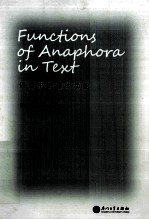图书介绍
语篇中回指的功能PDF|Epub|txt|kindle电子书版本网盘下载

- 梁鲁晋著 著
- 出版社: 厦门:厦门大学出版社
- ISBN:9787561530382
- 出版时间:2008
- 标注页数:280页
- 文件大小:12MB
- 文件页数:294页
- 主题词:英语-语言学-研究
PDF下载
下载说明
语篇中回指的功能PDF格式电子书版下载
下载的文件为RAR压缩包。需要使用解压软件进行解压得到PDF格式图书。建议使用BT下载工具Free Download Manager进行下载,简称FDM(免费,没有广告,支持多平台)。本站资源全部打包为BT种子。所以需要使用专业的BT下载软件进行下载。如BitComet qBittorrent uTorrent等BT下载工具。迅雷目前由于本站不是热门资源。不推荐使用!后期资源热门了。安装了迅雷也可以迅雷进行下载!
(文件页数 要大于 标注页数,上中下等多册电子书除外)
注意:本站所有压缩包均有解压码: 点击下载压缩包解压工具
图书目录
Chapter 1 Introduction1
1.1 The aim of this book1
1.2 The nature of anaphora2
1.3 Research questions6
1.4 Methodology7
1.5 Organization8
Chapter 2 Literature Review11
2.1 A brief history of anaphora study11
2.2 Contemporary approaches to anaphora18
2.3 Summary42
Chapter 3 Theoretical Foundations for Anaphora Study44
3.1 Construal of anaphora within the functional framework44
3.2 Remaining problems59
3.3 A proposed framework for anaphora62
3.4 Summary76
Chapter 4 Textual Function of Anaphora79
4.1 The lexical level80
4.2 The grammatical level91
4.3 The semantic level99
4.4 The textual level113
4.5 Summary137
Chapter 5 Interpersonal Function of Anaphora142
5.1 Understanding the interpersonal function of anaphora143
5.2 The writer-society relationship147
5.3 The writer-reader relationship158
5.4 Summary163
Chapter 6 Cognitive Function of Anaphora165
6.1 Frame-based integration165
6.2 Context-constrained inference184
6.3 Memory-related retrieval198
6.4 Summary211
Chapter 7 Anaphora in Application214
7.1 Testifying method214
7.2 Anaphora in text218
7.3 Summary231
Chapter 8 Conclusion233
8.1 Reflection on the research questions233
8.2 Implications of this research238
8.3 Limitations in anaphora study240
Bibliography242
Appendix Ⅰ:Three Texts for Sample Analysis259
Appendix Ⅱ:Findings of the Three Sample Texts276
Acknowledgements280
List of Figures16
Figure 2-1 Bühler's Organon-Model of Communication(after Bosch,1983:10,and Bühler 1934)16
Figure 2-2 Connection between historical views and contemporary approaches to anaphora17
Figure 2-3 The c-command diagram(adapted from Radford,1988:119)20
Figure 3-1 The place of anaphora within the semantic system in SFG framework(taken from Halliday&Hasan,1976:29)51
Figure 3-2 The place of anaphora within the system of reference(reproduced from Halliday&Hasan,1976:33)51
Figure 3-3 The place of anaphora in the realization relationship between the situational system and the semantic system(reproduced from Halliday,1985:2)55
Figure 3-4 The place of anaphora in the instantiation relationship(reproduced from Halliday&Matthiessen,1999:14)56
Figure 3-5 The functions of anaphora in text74
Figure 4-1 First and subsequent mention of participants in Example(12)(after Martin,1992:94)84
Figure 4-2 Clausal process types and subjectobject positions of the anaphors as participants in Example(17)94
Figure 4-3 The bi-dimensional characteristic of anaphora in Example(12)100
Figure 4-4 Ontological and linguistic reference of the anaphor"he"in Example(12)104
Figure 4-5 Anaphoric continuity and topical continuity in Example(25)119
Figure 4-6 Cohesive chains in Example(27)129
Figure 4-7 Interaction between the topic chain of"she"and the non-topic strings in Example(27)134
Figure 5-1 The role of anaphora in the two types of interpersonal relationship146
Figure 5-2 Notions related to reference point(taken from Langacker,1996:356)152
Figure 5-3 The switch of reference point in Example(30)153
Figure 5-4 Attribution through antecedent embedment156
Figure 5-5 Antecedent embedment in Example(31)156
Figure 5-6 Non-attribution through antecedent-anaphora pattern157
Figure 5-7 The antecedent-anaphora pattern in Example(29)158
Figure 6-1 The simple spatial framework of a truck183
Figure 6-2 Bridging anaphors within the spatial framework of a"truck"in Example(38)183
Figure 6-3 Two mapping relationships in the blend metaphorical anaphors197
Figure 6-4 The evoked senses of"home"211
Figure 7-1 Topicality establishment according to the frequency of anaphora of certain antecedents(measured against percentage;frequency:per one thousand words)220
Figure 7-2 Topicality-constrained anaphora types of major topical entities(measured against percentage;frequency:per one thousand words)222
Figure 7-3 Proportion of ba type to the other three anaphora types in three sample texts(measured against percentage;frequency:per one hundred anaphora types)223
Figure 7-4 Antecedents in three sample texts(measured against percentage;frequeney:per 1000 words)228
List of Tables131
Table 4-1 Process types,their meanings and key participants(reproduced from Halliday,1985:143)131
Table 4-2 Process types,their meanings and key participants of the topic chain of"she"in Example(27)132
Table 4-3 The anaphoric nominal groups with the possessive determiner"her"and the relationships expressed by it133
Table 7-1 Topicality establishment according to the frequency of anaphora of certain antecedents(measured against number)219
Table 7-2 Distribution of ba type as compared with the distribution of other anaphora types(measured against number)223